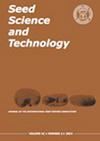克罗马蒂方程预测干燥过程中种子平衡水分含量的性能评价
IF 3
4区 农林科学
Q2 AGRONOMY
引用次数: 0
摘要
对于传统种子(基因)库来说,有效干燥种子和保持低含水量(MC)是至关重要的。Cromarty方程描述了干燥种子的MC和相对湿度(RH)的关系,基于它们的含油量,可以用来预测种子在受控环境(RH,温度)下干燥到平衡时的MC。然而,平衡MC-RH关系(“等温线”)不仅在不同物种的种子之间和取决于温度,而且还取决于种子是失去(解吸)还是获得(吸附)水分。考察了Cromarty方程在预测不同种子干燥平衡MC时的可靠性,并将其与Guggenheim-Anderson-De Boer (GAB)方程进行了比较,以模拟脱吸和吸附数据。Cromarty方程对油菜和大麦的解吸数据拟合较好(r2 = 0.98)。对于黄芥菜,种子MC估计过高,而对于黑豆、小麦、荞麦和豌豆,用Cromarty方程预测的MC平衡更接近吸附数据。总的来说,GAB方程提供了更好的数据拟合。虽然Cromarty方程是估计给定环境下种子MC的有用工具,但在危急情况下应谨慎使用。本文章由计算机程序翻译,如有差异,请以英文原文为准。
Assessment of the performance of Cromarty’s equation to predict seed equilibrium moisture content during drying
For conventional seed (gene)banking of orthodox seeds, it is essential to effectively dry the seeds and maintain a low moisture content (MC). Cromarty’s equation describes the MC and relative humidity (RH) relationship of drying seeds, based on their oil content, and can be used to predict the MC seeds would reach when dried to equilibrium in a controlled environment (RH, temperature). However, the equilibrium MC-RH relationship (‘isotherm’) varies not only between seeds of different species and depending on temperature, but also on whether seeds are losing (desorbing) or gaining (adsorbing) moisture. The reliability of Cromarty’s equation in predicting the equilibrium MC for drying different seed species was examined and compared with the Guggenheim-Anderson-De Boer (GAB) equation, to model both desorption and adsorption data. Cromarty’s equation provided a good fit to the desorption data for oilseed rape and barley ( R 2 = 0.98). For yellow mustard, seed MC was overestimated and for lupin, wheat, buckwheat and pea, the MC equilibria predicted by Cromarty’s equation were closer to the adsorption data. Overall, the GAB equation provided a better fit of the data. While Cromarty’s equation is a useful tool for estimating the MC of seeds under a given environment, it should be used with caution in critical situations.
求助全文
通过发布文献求助,成功后即可免费获取论文全文。
去求助
来源期刊

Seed Science and Technology
农林科学-农艺学
CiteScore
3.00
自引率
28.60%
发文量
36
审稿时长
>36 weeks
期刊介绍:
Seed Science and Technology (SST) is an international journal featuring original papers and articles on seed quality and physiology related to seed production, harvest, processing, sampling, storage, genetic conservation, habitat regeneration, distribution and testing. A journal that meets the needs of researchers, advisers and all those involved in the improvement and technical control of seed quality. Published every April, August and December.
 求助内容:
求助内容: 应助结果提醒方式:
应助结果提醒方式:


